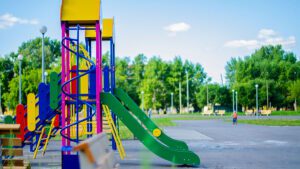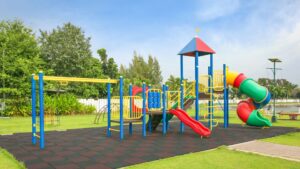Abrir un parque de camas elásticas puede ser un negocio apasionante y potencialmente lucrativo. Pero también requiere mucho capital. Si te tomas en serio la idea de abrir un parque, necesitas un presupuesto claro que cubra la instalación inicial, la seguridad y el cumplimiento de las normas, las operaciones en curso y un colchón para imprevistos.
Resumen rápido (si tiene prisa)
- Rango típico de puesta en marcha (equipos + equipamiento): $233,000–$467,000 (estimación parque medio)
- Seguro (anual): $5,800–$11,700 (estimación)
- Principales factores de coste: edificio (compra frente a alquiler), selección de equipos, renovación del emplazamiento, dotación de personal, marketing, sistemas de seguridad y mantenimiento.
- Consejo: Planifique por fases: abra con las principales atracciones y añada funciones cuando se estabilice el flujo de caja.

1. Explicación de los principales costes iniciales
1.1 Construir: ¿comprar, alquilar o construir?
- Comprar Ofrece estabilidad a largo plazo, pero requiere un mayor desembolso inicial y posibles reformas importantes. Las necesidades de capital son mayores, pero el control es mayor.
- Alquiler de reduce el capital inicial y permite abrir más rápido, pero las condiciones de arrendamiento pueden limitar la capacidad de realizar reformas estructurales (y el alquiler puede subir).
- Nueva construcción es ideal para un diseño personalizado, pero lleva más tiempo (a menudo un año o más) y cuesta más.
Su elección determina muchos costes posteriores: HVAC, requisitos de altura del techo, soportes estructurales para atracciones altas y aparcamiento.
1.2 Equipamiento y atracciones (artículos de gran valor)
Los parques de camas elásticas modernos son centros multiactividad. Las atracciones típicas incluyen:
- Cama elástica de salto libre
- Carriles de volteo
- Fosos de espuma y airbags
- Pistas de dodgeball
- Baloncesto de mates/trampolín
- Carreras de obstáculos estilo ninja
- Funciones interactivas y de realidad aumentada
Presupuesto medio de equipamiento para un parque de tamaño medio se estimó en $200k-$400k. Esa gama depende del número y la variedad de atracciones, la personalización y el equipamiento nuevo frente al usado.
1.3 Trazado, seguridad y trabajos estructurales
No escatimes:
- Suelos y acolchados antichoque
- Salidas de incendios, aspersores, detectores de humo
- Soportes estructurales y anclajes resistentes
- Iluminación, sonido y ventilación
- Acceso ADA y aseos
Estos costes de construcción varían mucho en función del estado del edificio elegido, pero a menudo pueden rivalizar con los costes de equipamiento en los inmuebles más antiguos.

2. Gastos de funcionamiento que debe presupuestar
2.1 Personal
Un parque de camas elásticas requiere mucho personal. Las funciones incluyen:
- Recepción
- Asistentes/supervisores de camas elásticas (personal de seguridad)
- Personal de comidas y bebidas (si procede)
- Coordinadores de eventos (fiestas, reservas de empresa)
- Limpiadores y técnicos de mantenimiento
- Director y directores adjuntos
Regla de oro: tener al menos un supervisor formado por cada ~30 jugadores. Si su parque trabaja muchas horas (más de 70 horas a la semana), cuente con dos equipos completos.
2.2 Mantenimiento y piezas
Los equipos necesitan atención constante: sustitución de acolchados, muelles, alfombrillas y herrajes. El mantenimiento preventivo reduce el tiempo de inactividad, pero cuesta dinero. Planifica un presupuesto anual de mantenimiento y haz un seguimiento de los ciclos de sustitución de los artículos de mayor desgaste.
2.3 Marketing y captación de clientes
Asigne un presupuesto de marketing significativo para:
- Anuncios digitales locales (Google/FB/Instagram)
- Eventos y asociaciones escolares
- Relaciones públicas y relaciones con la comunidad
- Promociones de temporada
Un sólido plan de marketing en la fase de apertura es esencial para acelerar el boca a boca y generar reservas anticipadas para fiestas y grupos.
2.4 Seguros y gestión de riesgos
El seguro no es negociable. La estimación original de $5,000-$10,000 al año. Cubre los riesgos del edificio/propiedad y el seguro de responsabilidad civil. Las primas reales dependen de la ubicación, el historial de siniestros, las medidas de seguridad y los límites de cobertura.
Invierta en formación del personal y en sistemas de seguridad documentados: las aseguradoras recompensan a los operadores menos arriesgados con mejores tarifas.

3. 3. Estrategias de financiación
3.1 Vías comunes de financiación
- Préstamos bancarios / préstamos comerciales: opción tradicional; compare los tipos de interés y las condiciones de reembolso.
- Inversores de capital: un inversor puede inyectar capital a cambio de propiedad, pero esperar cambios en la gobernanza y expectativas de salida.
- Subvenciones: raros para espectáculos, pero pueden aplicarse algunas subvenciones locales de desarrollo económico o fondos para pequeñas empresas.
- Financiación de proveedores/arrendamiento con opción a compra: A veces, los fabricantes de equipos ofrecen opciones de financiación.
3.2 Consejos presupuestarios
- Implantación gradual: abrir con atracciones básicas y añadir funciones especializadas más adelante.
- Previsiones de ingresos conservadoras: no sobreestime la asistencia: elabore su plan de tesorería basándose en cifras realistas.
- Fondo de reserva: mantener una contingencia (10-20% del capex inicial) para sobrecostes inesperados.

4. Consideraciones sobre el diseño y la experiencia del cliente
4.1 Flujo y visibilidad
Diseñe líneas de visión claras para que los supervisores y los padres puedan controlar fácilmente la actividad. Separe las zonas de mayor actividad (balón prisionero, circuitos ninja) de las zonas para niños y familias.
4.2 Espacios para fiestas y eventos
Las fiestas de cumpleaños y los eventos de grupo son motores de ingresos: diseñe salas de fiestas específicas para que la entrega de pedidos y las ventas sean más eficientes.
4.3 Alimentación y bebidas
Añade una cafetería o un bar para obtener ingresos por tiempo de permanencia. Considera la posibilidad de arrendar a un socio si el servicio de comidas no es tu principal competencia.
4.4 Accesibilidad e inclusión
Garantizar el cumplimiento de la ADA y considerar sesiones adaptadas a las necesidades sensoriales de los visitantes neurodiversos.

5. Seguridad y cumplimiento: no negociables
- Cumpla los códigos de construcción locales y cualquier norma de seguridad del sector.
- Implantar normas de seguridad escritas, señalización y sesiones informativas de orientación dirigidas por el personal.
- Llevar listas de comprobación diarias y registros de mantenimiento.
- Ofrezca botiquines de primeros auxilios, DEA y personal formado in situ.
Unos sistemas de seguridad sólidos reducen la responsabilidad y aumentan la confianza de los clientes, dos factores cruciales para el éxito a largo plazo.

6. Flujos de ingresos y palancas de beneficios
- Entrada general y tarifas por hora de salto
- Fiestas de cumpleaños y reservas de grupos
- Afiliaciones y pases de temporada
- Mercancías y concesiones
- Eventos de empresa y paquetes de trabajo en equipo
- Eventos especiales fuera de horario (clases de fitness, ligas de trampolín)
Maximice el gasto por visitante con complementos (calcetines, taquillas, paquetes de fotos).

7. Consejos prácticos de los operadores
- Realice un estudio de mercado en profundidaddemografía, competencia, calendarios escolares y sensibilidad local a los precios.
- Elija bien la ubicaciónAccesibilidad: la accesibilidad y el aparcamiento importan tanto como el alquiler.
- Dar prioridad a la seguridadUn solo incidente de seguridad puede dañar la reputación.
- Contratar y formar bienEl personal de calidad garantiza la seguridad de los huéspedes y su regreso.
- Empezar con poco y ampliarValidar el concepto y luego ampliarlo.
Un parque de camas elásticas puede ser tanto un alegre centro comunitario como un negocio rentable, pero sólo con una planificación minuciosa. Planifique de forma realista el capital inicial (prevea ≈ $233k-$467k para una instalación mediana), tenga en cuenta el seguro anual (≈ $5.8k-$11.7k), y dé prioridad a la seguridad y al marketing desde el primer día. Con una financiación inteligente, una puesta en marcha escalonada y unas operaciones sólidas, podrá construir una atracción sostenible y divertida que haga volver a los clientes.




